NASA APOD #929-937
#929 The Barren Moon January 03, 1998
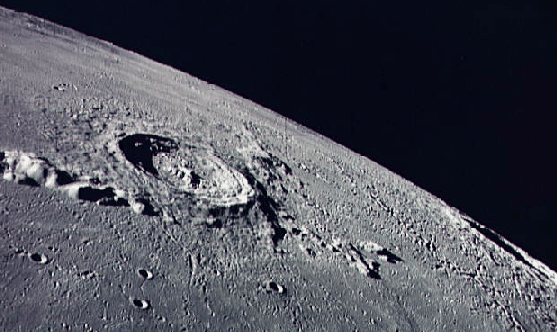
“The above photo, taken as the Apollo 17 astronauts orbited the Moon in 1972, depicts the stark lunar surface around the Eratosthenes and Copernicus craters. Many similar images of a Moon devoid of life are familiar to denizens of the space age. Contrary to this modern perception, life on the Moon was reported in August of 1835 in a series of sensational stories first published by the New York Sun - apparently intended to improve the paper's circulation. These descriptions of lunar life received broad credence and became one of the most spectacular hoaxes in history. Supposedly based on telescopic observations, the stories featured full, lavish accounts of a Moon with oceans and beaches, teeming with plant and animal life and climaxing with the report of sightings of groups of winged, furry, human-like creatures resembling bats!"
Copyright: Public domain
#930 Fractal Interstellar Dust Up-Close January 04, 1998
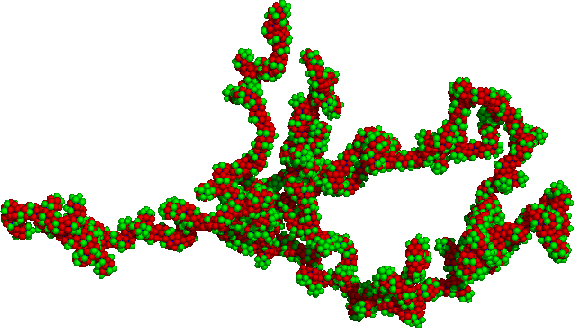
“Our universe is a very dusty place. Dust usually shows its presence by blocking out light emitted from stars or nebulae behind it, sometimes creating the illusion of a horse's head or a sombrero hat. But nobody really knows what a typical interstellar dust grain looks like. By studying how dust absorbs, emits, and reflects light, astronomers do know that interstellar dust is much different than the cell and lint based dust found around a typical house. Interstellar dust grains are composed mostly of carbon, silicon, and oxygen and are usually less than about 1/1000 of a millimeter across. Recent work indicates that most dust grains are not spherical. The above picture shows the result of a fractal adhesion model for dust grains involving random conglomerates of spherical compounds of different properties, here artificially highlighted by different colors."
Copyright: UCLA
#931 Earth's Richat Structure January 05, 1998
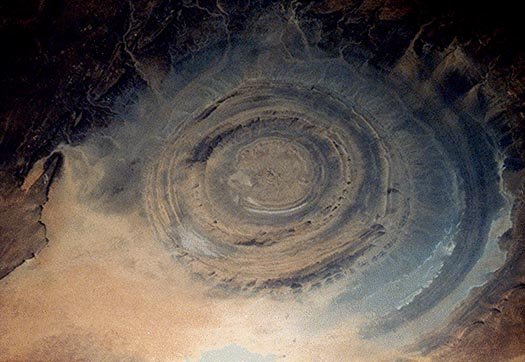
“What on Earth is that? The Richat Structure in the Sahara Desert of Mauritania is easily visible from space because it is nearly 50 kilometers across. Once thought to be an impact crater, the Richat Structure's flat middle and lack of shock-altered rock indicates otherwise. The possibility that the Richat Structure was formed by a volcanic eruption also seems improbable because of the lack of a dome of igneous or volcanic rock. Rather, the layered sedimentary rock of the Richat structure is now thought by many to have been caused by uplifted rock sculpted by erosion. Why the Richat Structure is nearly circular remains a mystery."
Copyright: Public domain
#932 The Red Spider Planetary Nebula January 06, 1998
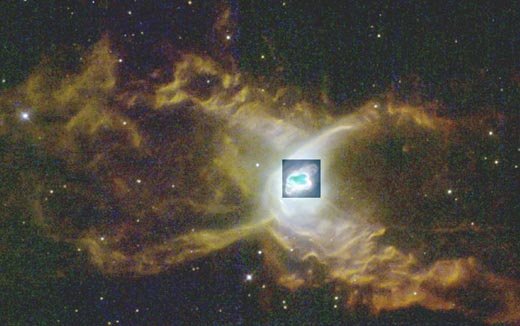
“Oh what a tangled web a planetary nebula can weave. The Red Spider Planetary Nebula shows the complex structure that can result when a normal star ejects its outer gases and becomes a white dwarf star. Officially tagged NGC 6537, this two-lobed symmetric nebula houses one of the hottest white dwarfs ever observed, probably as part of binary star system. Internal winds emanating from the central stars, shown in the central inset, have been measured in excess of 300 kilometers per second. These hot winds expand the nebula, flow along the nebula's walls, and cause gas and dust to collide. Atoms caught in these colliding shocks radiate light shown in the above representative-light picture."
Copyright: Public domain
#933 The Colorful Moon January 07, 1998
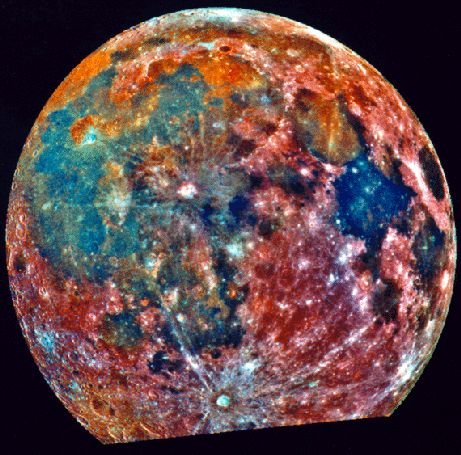
“Do you recognize the Earth's Moon when you see it? The crazy, patchwork appearance of this false color image makes this nearly full view of our Moon's familiar nearside look very strange. The image was taken in 1992 by the Galileo spacecraft enroute to Jupiter. The Sea of Tranquillity (Mare Tranquillitatis) is the blue area at right, the Ocean of Storms (Oceanus Procellarum) is the extensive blue and orange area on the left, and white lines radiate from the crater Tycho at bottom center. Three filters were used to make three separate exposures, combined in an exaggerated color scheme to emphasize composition differences - blue hues reveal titanium rich areas while orange and purple colors show regions relatively poor in titanium and iron. NASA soon plans to conduct an extensive remote exploration of the lunar surface, including a search for water ice near the lunar South Pole, with the Lunar Prospector spacecraft."
Copyright: Public domain
#934 Destination: Moon January 08, 1998
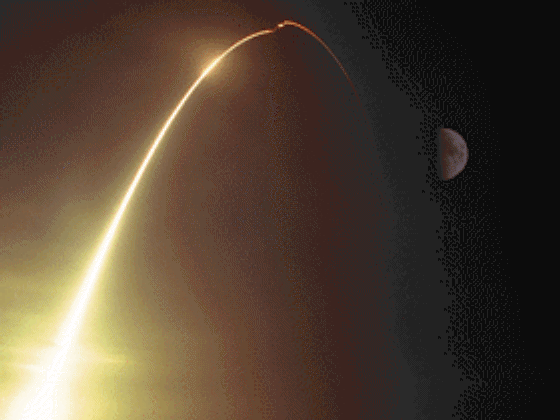
“Tuesday, January 6, at 9:28 p.m. EST, NASA's Lunar Prospector spacecraft climbed into the sky above Cape Canaveral Air Station riding an Athena II rocket. Representing NASA's first Moon mission since the 1972 flight of Apollo 17, this launch also occurred on the 30th anniversary of the launch of the Surveyor 7 lunar lander. The three stage launch vehicle's fiery trail is in the foreground of this time exposure while the Moon, near first quarter phase, is shown in the background some 250,000 miles from the Cape. Prospector will cover that distance in about 5 days, entering lunar orbit on Sunday. Prospector carries no cameras to image the well-photographed lunar surface. Instead, its array of instruments will map the lunar gravity, magnetic field, internal structure, and surface composition. The result, a detailed global view of current lunar properties, is expected to dramatically impact humanity's understanding of the origins of the Moon and the Solar System. From its vantage point in polar orbit, only 63 miles above the lunar surface, Prospector will also conduct a sensitive search for water ice which may be preserved in permanent shadow at the Moon's South Pole."
Copyright: Public domain
#935 Saturnian Aurora January 09, 1998
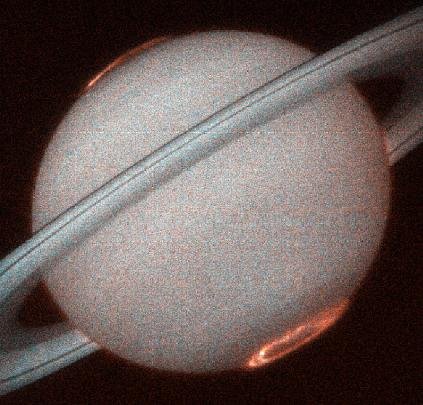
“Girdling the second largest planet in the Solar System, Saturn's Rings are one of the most spectacular sights for earthbound telescopes. This recently released image, from the orbiting Hubble Space Telescope's STIS instrument, offers a striking view of another kind of ring around Saturn - pole encircling rings of ultraviolet aurora. Towering more than 1,000 miles above the cloud tops, these Saturnian auroral displays are analogous to Earth's. Energetic charged particles in the Solar Wind are funneled by the planet's magnetic field into polar regions where they interact with atmospheric gases. Following the ebb and flow of Saturn's aurora, researchers can remotely explore the planet's atmosphere and magnetic field. In this false color image, the dramatic red aurora identify emission from atomic hydrogen, while the more concentrated white areas are due to hydrogen molecules. In 2004, NASA plans to begin making close-up studies of the Saturnian system with the Cassini Spacecraft."
Copyright: Public domain
#936 Disorder in Stephan's Quintet January 10, 1998
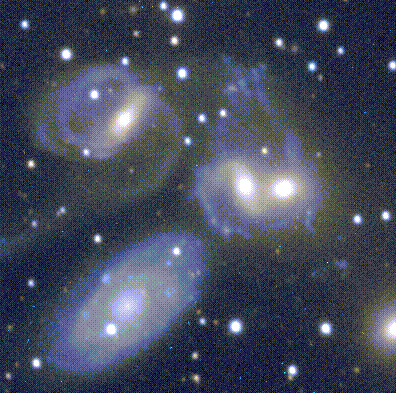
“What are five closely grouped galaxies doing in this image? The grouping is commonly known as Stephan's Quintet. Four of the galaxies show essentially the same redshift suggesting that they are at the same distance from us. The large bluish spiral below and left of center actually has a smaller redshift than the others, indicating it is much closer. It is probably a foreground object which happens to lie along the line of sight to the more distant galaxies. Of the four distant galaxies, three seem to be colliding, showing serious distortions due to gravitational tidal forces. The fourth is a normal appearing elliptical galaxy (at the lower right edge of the field). Recent results suggest that collisions play an important role in the life cycles of galaxies."
Copyright: Public domain
#937 Abell 2218: A Galaxy Cluster Lens January 11, 1998
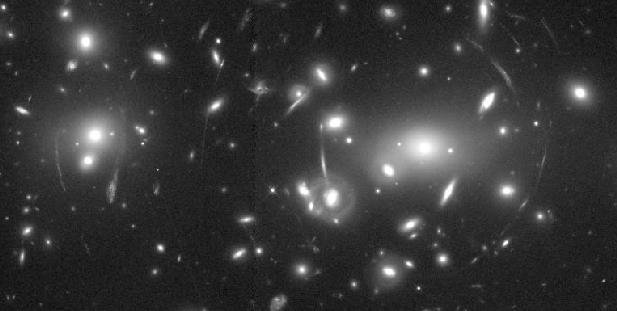
“Gravity can bend light. Almost all of the bright objects in this Hubble Space Telescope image are galaxies in the cluster known as Abell 2218. The cluster is so massive and so compact that its gravity bends and focuses the light from galaxies that lie behind it. As a result, multiple images of these background galaxies are distorted into faint stretched out arcs - a simple lensing effect analogous to viewing distant street lamps through a glass of wine. The Abell 2218 cluster itself is about 3 billion light-years away in the northern constellation Draco."
Copyright: Public domain
Upvote! Resteem! Comment! As you like it! Thank you for attention!